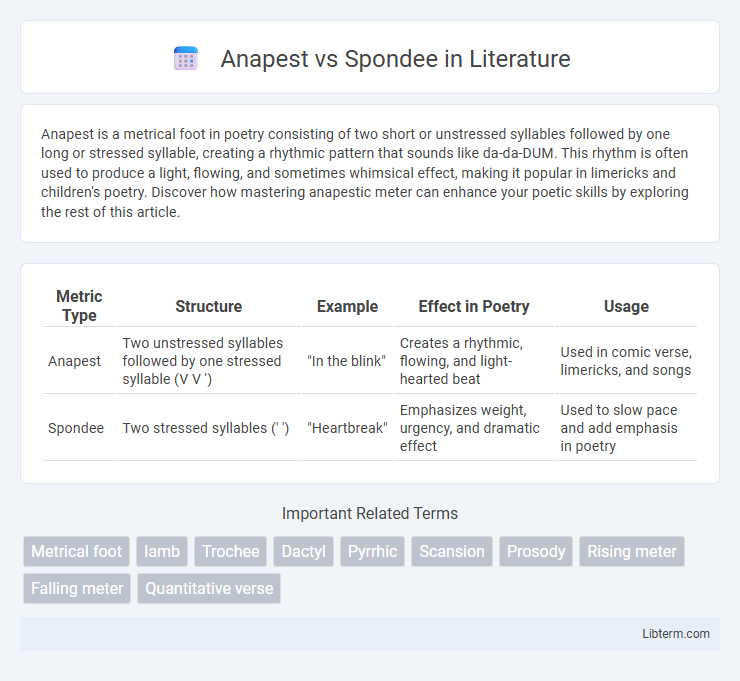Anapest is a metrical foot in poetry consisting of two short or unstressed syllables followed by one long or stressed syllable, creating a rhythmic pattern that sounds like da-da-DUM. This rhythm is often used to produce a light, flowing, and sometimes whimsical effect, making it popular in limericks and children's poetry. Discover how mastering anapestic meter can enhance your poetic skills by exploring the rest of this article.
Table of Comparison
| Metric Type | Structure | Example | Effect in Poetry | Usage |
|---|---|---|---|---|
| Anapest | Two unstressed syllables followed by one stressed syllable (V V ') | "In the blink" | Creates a rhythmic, flowing, and light-hearted beat | Used in comic verse, limericks, and songs |
| Spondee | Two stressed syllables (' ') | "Heartbreak" | Emphasizes weight, urgency, and dramatic effect | Used to slow pace and add emphasis in poetry |
Introduction to Anapest and Spondee
Anapest and spondee are metrical feet used in poetry to create rhythm and emphasis. Anapest consists of two unstressed syllables followed by a stressed syllable (da-da-DUM), often producing a light, upbeat rhythm, while spondee has two stressed syllables (DUM-DUM), generating a heavy, forceful effect. Understanding the distinctive patterns of anapest and spondee enhances the analysis of poetic meter and the emotional tone conveyed by a poem.
Defining Anapest: Structure and Examples
Anapest is a metrical foot in poetry consisting of two short or unstressed syllables followed by one long or stressed syllable, often creating a rhythmic, flowing effect as seen in the word "understand." This structure contrasts with the spondee, which features two consecutive stressed syllables, producing a heavier, more forceful rhythm. Examples of anapestic meter include lines like "In the blink of an eye," where the pattern emphasizes a light, rapid cadence.
Understanding Spondee: Structure and Examples
Spondee is a metrical foot consisting of two stressed syllables (' '), creating a heavy and deliberate rhythm in poetry. This structure contrasts with the anapest, which has two unstressed syllables followed by a stressed one (V V '), producing a lighter, more flowing meter. Common examples of spondee include compound words like "heartbreak" and "dead-end," where equal emphasis on both syllables enhances the poem's dramatic effect.
Key Differences Between Anapest and Spondee
Anapest consists of two unstressed syllables followed by a stressed syllable, creating a distinct rhythmic pattern often found in light or lyrical poetry. Spondee, on the other hand, features two equally stressed syllables, producing a heavy, deliberate emphasis typically used to convey strength or urgency. The primary difference lies in their stress patterns and the resulting tone, with anapest generating a flowing, upbeat rhythm and spondee delivering a powerful, emphatic effect.
Historical Use in Poetry
Anapest and spondee are metrical feet frequently used in classical and English poetry to create rhythm and emphasis. Historically, anapests, consisting of two unstressed syllables followed by a stressed syllable, were favored in comedic and lyrical poetry for their light, flowing cadence, exemplified in works by Lord Byron and Gerard Manley Hopkins. Spondees, marked by two equally stressed syllables, served as a tool for slowing the pace and adding dramatic weight, prominently utilized in ancient Greek epic poetry like Homer's Iliad and adapted by poets such as T.S. Eliot for emotional intensity.
Effects on Rhythm and Tone
Anapest creates a light, rapid rhythm with two unstressed syllables followed by a stressed one, producing a galloping or flowing effect that often conveys excitement or urgency. Spondee features two consecutive stressed syllables, generating a heavy, emphatic beat that slows the pace and adds weight or intensity to the tone. The contrast between anapest's buoyant cadence and spondee's deliberate emphasis shapes the poem's overall mood and emotional impact.
Famous Poems Featuring Anapests
Famous poems featuring anapests include "The Night Before Christmas" by Clement Clarke Moore and "The Destruction of Sennacherib" by Lord Byron, both exemplifying the rhythmic elegance of the anapestic meter. Anapests consist of two unstressed syllables followed by a stressed syllable, creating a galloping cadence that contrasts with the spondee's pair of equally stressed syllables. Understanding the use of anapests in classic poetry enhances appreciation of rhythmic variation and emotional impact in poetic composition.
Notable Poems Using Spondees
Notable poems using spondees include T.S. Eliot's "The Waste Land," where spondaic meter intensifies the poem's somber and heavy atmosphere. Edgar Allan Poe's "The Bells" incorporates spondees to mimic the rhythmic ringing and amplify emotional impact. Spondaic feet also appear in Shakespearean tragedy dialogues to emphasize dramatic tension and create a pounding, forceful rhythm.
Choosing Between Anapest and Spondee in Writing
Choosing between anapest and spondee in writing depends on the desired rhythm and mood of the poem or text. Anapest, with its two unstressed syllables followed by a stressed one, creates a lively, upbeat, and flowing meter ideal for lighthearted or narrative verses. Spondee, consisting of two equally stressed syllables, produces a heavy, emphatic beat that enhances dramatic moments or emphasizes key ideas in your writing.
Tips for Identifying Anapest and Spondee
Anapest features two unstressed syllables followed by a stressed syllable (da-da-DUM), commonly found in poetic meters like limericks, while Spondee consists of two equally stressed syllables (DUM-DUM), often used to emphasize a phrase. Identifying anapests involves listening for the rising rhythm and lighter start before a strong beat, whereas spotting spondees requires detecting the forceful, steady beat without variation in stress. Familiar examples include "understand" for anapest and "heartbreak" for spondee, aiding in distinguishing these metrical feet within poetry analysis.
Anapest Infographic

 libterm.com
libterm.com